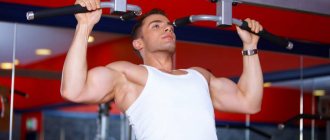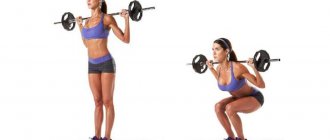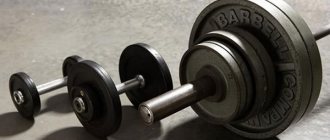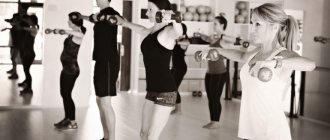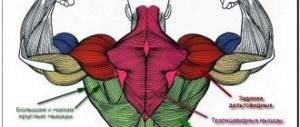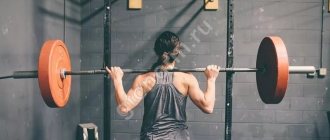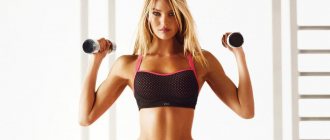What muscles work when performing a deadlift?
The main muscles involved in the deadlift are:
- Latissimus dorsi muscles;
- Gluteus maximus muscles;
- Thigh muscles (medial, lateral, rectus muscles);
- Trapezius muscles;
- Adductor muscles of the thighs.
Also involved in deadlifting:
- Biceps;
- Deltoid muscles;
- Flexor and extensor muscles.
Muscles secondary to deadlifting:
- Rectus abdominis muscle;
- Calf muscles (lateral and medial heads).
In fact, the deadlift uses a third of all the muscles in the body.
Deadlift technique
Foot placement
Your feet should be slightly wider than your hips to give your body better balance. It is important not to place them too widely, or, conversely, too narrowly. The socks should look straight, you can place them slightly apart. The main thing is that the stance is firm, confident and comfortable (read about the technique of performing squats with a barbell).
Bar grip
As a rule, athletes use a medium grip, but with their hands positioned wider than their hips, as this is considered the most comfortable and safe. You can also use an overhand grip, with one palm facing outward and the other inward. This ensures less slipping of the barbell in the hands, and significantly helps the athlete hold heavy weights.
However, each type of grip has different tasks. The mixed grip is used by those whose task is to lift as much weight as possible. Those for whom body contours and harmoniously developed muscles are more important should give preference to direct or reverse grips so that the muscles in each hand develop synchronously. In addition, some trainers consider it necessary to abandon the mixed grip, since it is possible to damage the muscles due to an imbalance of the load.
Preparing to lift the barbell
When the athlete's palms rest on the barbell and he is ready to lift it, he needs to make sure that the bar is clearly above the feet, and exactly in the middle of each foot. The back should be tense and slightly arched, the head looking straight. The knees should be bent so that the hips and buttocks are slightly higher.
Lifting the bar
When lifting the barbell, your back should be straight and your chest and shoulders should be pulled up. The knees straighten, the thighs and buttocks contract and move forward slightly so that the bar of the bar slides over the shins. Basically, when lifting a barbell, it is the muscles of the back of the arms, hips and buttocks that work. When the body is fully straightened, you need to hold the barbell for 2 seconds and then lower it down. The back remains straight, the chest is raised, the head looks straight. The hips begin to push back and the knees bend until the barbell is on the floor (read about the most popular barbell exercises).
How much does a barbell weigh?
All more or less experienced athletes who visit the training room know what a “barbell”, “barbell” is, their varieties and methods of use. But beginners have to become familiar with these concepts. They need to learn to figure out which bar they need to use during certain training sessions. But first of all, they must know the names, differences and functionality of all types of this effective training equipment.
How much does a barbell weigh by type?
Straight standard Olympic bar - 20 kg
This bar is available in every gym. It is very popular among weightlifters and deservedly bears the name “classic”. Often the straight bar is covered with a raised notch, due to which it does not slip and does not twist the hands. The presence of air in the recesses prevents your hands from sweating. This notch allows athletes to work with the greatest weight of the barbell.
Straight Olympic bar for women - 25 kg
This modification is used to train female weightlifters in preparation for sports competitions. It is almost no different from the male vulture. The only difference is the absence of notches, its length and weight (it is slightly shortened and lightweight).
Powerlifting bar - weighs 30 kg
This variation is applicable for training with a heavier barbell weight, one that a regular bar cannot support. This bar is made of high-strength steel and is used in powerlifting. Its difference is not only in length and weight, but also in rigidity. Withstanding a higher load, it bends and springs less, and reduces the oscillatory movements that occur during exercise. Its qualities are surpassed only by a special squat bar.
Universal bar for home training - 10 kg
This option is suitable for home training. If you don’t have the opportunity to train in the gym and don’t want to lose shape, you can purchase this inexpensive bar. But keep in mind its low quality. You can perform almost all exercises aimed at training the delta muscles and biceps on it. But at the same time, you cannot bench press on it, since due to its shortened length you are not able to place the barbell on the rack.
EZ bar - 6.5 kg
This equipment was developed for people with limited mobility of the hands and is aimed at training the biceps and triceps, including the work of the forearm. It makes it more convenient to grab without twisting your hands and taking the load off your forearms and wrists. You can also do the French bench press with it. If you feel discomfort in the wrist joint when performing barbell rows to the chin, you should try training with an EZ-shaped bar. However, if you are doing exercises to increase forearm strength, you should try lifting the barbell with an overhead grip, and when bending your wrist, use an underhand grip.
W-bar - 6.8 kg
This version of the neck is more curved, which makes it different from the previous design. It is most comfortable and effective when performing the French press with a neutral grip, when the athlete's palms are directed forward. In this case, the entire load is transferred to the triceps. By performing exercises on this bar, you can train not only the triceps muscle, but also the biceps.
Trap bar – 7 kg
In its form, this design is fundamentally different from all previous types. Having a hexagon shape with handles on the sides, it looks like a trap and is most convenient when performing exercises such as shrugs, deadlifts, and French presses. With this training, the muscles of the back, legs and buttocks are more loaded. This type of bar is the safest and most comfortable, since the athlete is located exactly in the center, and the load is divided on the sides of the athlete. By performing deadlift exercises, you have the opportunity to do more repetitions. It is mainly suitable for beginners.
When choosing exercises to train your body with a barbell, you will now have the opportunity to decide on the right bar for your workout. Knowing its types and functionality, you can more effectively develop the desired muscle group. However, remember that the main thing during training is the convenience and comfort of the athlete. Only in this case will training benefit you.
Common mistakes when performing deadlifts
- Back twisting.
The chest and shoulders are lowered down, and the back is bent like a wheel - this is an incorrect and extremely dangerous position for lifting the barbell while standing. - Dropping the hips.
The hips do a lot of the work when lifting a barbell. They should be tense and should be held above the knees. You cannot sit down deeply, lowering your hips down. - Deviation.
When lifting the barbell, the body should only be in a vertical position. Leaning back or forward is unacceptable (read how to do a standing barbell press correctly).
Deadlift Safety
The main thing when deadlifting is to make sure that the spine and muscles remain intact and unharmed. Even without lifting heavy weights, you can cause significant injuries to your body.
- The spine should be straight when lifting the barbell.
Its twisting or excessive arching can provoke a shift of the vertebral discs. The result can be, for example, pinched nerves and severe pain. - When deadlifting, it is allowed to sharply lower the barbell down
without controlling this process, as happens, for example, when pressing a barbell or dumbbells, when each stage must be done slowly and smoothly. When lowering the barbell down, the spine experiences greater loads than when lifting, so you should not overload it again. - The row should start from the bottom position, not the top.
The barbell must be lifted from the floor, not removed from the rack and lowered. The reason is that the spine and shoulder blades must be properly secured before the lift begins. - Some athletes experience weakness after lifting the barbell
, some even faint. The reason here is not so much the weight that the athlete lifts, but rather internal problems. Dizziness and weakness are felt by those whose blood pressure is initially deviated from the norm (hypertensive or hypotensive). This problem cannot be ignored, since constant sudden changes in pressure can lead to serious vascular problems. In addition, fainting in the gym may be unsuccessful, and the person will cause mechanical injuries to himself. - To avoid muscle tears and spinal injuries, you don’t need to suddenly switch to heavy weights
, they need to be added gradually. - The head should look straight when pulling the barbell up.
It should be fixed in one position and not move down or tilt back. This will help avoid injuries to the small cervical vertebrae (read how to avoid mistakes when performing the bench press).
Types and weights of barbells
Content
- Rod design
- Types, weight and other parameters
- Types of vultures
- Tips for choosing
- Where to buy and how much does it cost?
The article talks about what types of bars there are in shape and purpose, how much a barbell bar weighs, how to choose it correctly, and also how much it will cost, depending on the manufacturer.
Rod design
The projectile consists of the following parts:
- neck;
- rotating bushings;
- removable disks;
- locks
The barbell is the most popular sport and allows you to use all the major muscles of a person during training. It allows you to build muscle mass while developing their strength and endurance. The bar is the basis of the barbell and its selection should be given maximum attention. It is selected depending on the group of muscles being trained.
Types, weight and other parameters
The parameters of the rod, depending on its name, are given below, namely:
- The Olympic barbell involves the use of a straight bar 2.2 m long. Its diameter is 28 mm, weight is 20 kg, and the diameter of the landing sleeves at the ends is 50 mm. This bar allows you to perform exercises with significant weight, including a wide grip.
- The difference between the barbell for powerlifting is that the diameter has been increased to 29 mm, which increases its rigidity. This makes it possible to lift more weight than using an Olympic barbell.
- The standard barbell has a bar with a diameter of 25 mm. Its weight is 20 kg, and the diameter is the same along its entire length.
- The women's Olympic barbell is similar to the men's barbell, but its length is 2.05 m and its weight is 15 kg with a bar diameter of 25 mm. There are no notches on it.
- The training bar is manufactured according to European or American standards. The difference is in the diameter of the neck: for European – 30.48 mm, for American – 25.4 mm. These diameters are maintained throughout the entire length of the neck. Moreover, the length of the neck in both cases can be 120 and 180 cm.
- The deadlift bar resembles an Olympic barbell, and due to its more flexible bar, it allows you to increase the weight lifted. This bar is not used by the International Powerlifting Federation (IPF).
- The squat bar is also banned in the IPF. A straight bar with a diameter of 32 mm is used, its weight with locks is about 30 kg, the total length should not be more than 2.4 m.
- A barbell with an EZ bar is used to train the arm muscles (biceps and triceps).
- The W-bar barbell is used for the same training as the previous one, but with improved grip conditions.
- A barbell with a T-bar is used to train the back muscles. The load is placed on the lower end of the bar, and the other end is secured. Raising the lower end of the barbell is done on a platform or on a simulator.
- A barbell with a trap bar is used for deadlift training. It is a preparatory tool before training with a straight barbell. Exercises with this bar allow you to reduce the force load on the lower back, since the arms are in a natural position. The handles for gripping the bar are located on the axis of the placed weights. When a person is inside the bar, he takes the barbell by the side handles and lifts the barbell along the optimal trajectory. In this case, the load moves in a straight line, which reduces the load on the joints and spine.
Types of vultures
There are the following types:
- straight;
- EZ-neck;
- W-shaped neck;
- T-neck;
- trap neck.
The most common are straight bars. They are used on most rods existing today.
These include rods such as:
- Olympic;
- for powerlifting;
- standard;
- women's Olympic;
- training;
- for traction;
- for squats.
The main exercises performed using a barbell are given below:
- jerk;
- push;
- various presses;
- deadlift;
- shrugs;
- squats;
- lifting the barbell and others.
Most of the straight bars have a raised notch, which allows you to work with significant weight, because the bar does not tear out of your hands. In this case, the hands do not sweat due to the presence of air in the grooves. To avoid the appearance of calluses during training, you should use gloves.
- The EZ bar (curved bar) is used on barbells of the same name to perform exercises to develop arm muscles (biceps and triceps). Its use allows you to relieve stress from your forearms and wrists during training. When using this bar, the wrists are in an anatomically more correct position.
- The W-neck is a modified version of the EZ-neck. It provides a close to neutral grip and is used to perform the same exercises.
- The T-bar provides for attaching a load to the bottom of the barbell and is used to perform exercises such as deadlifts, thereby developing the back muscles.
- The trap bar is shaped like a hexagon with handles on the sides. It is used to perform exercises such as deadlifts, shrugs, and bench presses. When performing them, the load falls on the muscles of the legs, back and buttocks.
Tips for choosing
Depending on the financial potential of a particular person, the following options are possible:
- attending classes in a gym or fitness club following the recommendations of the trainer;
- purchasing the necessary equipment for practicing at home.
In the first case, all questions about choosing a bar will disappear; all equipment will be provided in the required range and at the right time.
In the second case, it is necessary to provide for the solution of the following issues:
- developing or finding a list of exercises to obtain the desired result to improve your body;
- finding a place to conduct classes at home;
- compiling a list of necessary equipment for classes;
- are there the necessary funds to purchase it;
- How will relatives and neighbors react to such activities?
Let's look at these questions in more detail.
Compiling a list of exercises to achieve the desired result to improve your body can be done in two ways:
- independently study the recommendations of trainers or people who have been doing this for a long time, using books or websites on the Internet;
- listen to lectures by specialists or speeches by famous athletes about the types of training and the results they achieved.
According to the selected list of exercises for developing your body, a list of equipment necessary for training is compiled. When choosing a list of exercises using a barbell, you need to determine the type of barbell that is supposed to be used during training.
When practicing powerlifting at home, you will need the following equipment (subject to financial issues being resolved):
- training bar (its size is determined depending on the size of the available room);
- bench press bench;
- barbell rack.
In this case, it is better to choose a barbell with a bar length of 1.8 m and a diameter of 30 or 25 mm. A bar with this length expands the capabilities of the barbell when performing various exercises. With a bar diameter of 25 mm, the barbell can be used not only by yourself, but also by all family members. The set of weights on the bar can be varied.
When purchasing a bar, you need to check its condition, see if it is comfortable for you, if there are any defects on it, or if it is bent. You also need to find out its weight and the maximum possible load that can be allowed when using it (the weight of the bar with discs).
To reduce noise during training, it is better to use rubber-coated MB Barbell discs, manufactured in Petrozavodsk. They will keep the floor in its original form. For a bar with a diameter of 25 mm, the weight of the discs starts from 0.5 kg and ends at 25 kg. The purchase of discs can be done gradually, increasing the weight of the bar to maximum values.
It is advisable not to buy a ready-made barbell, but to assemble it yourself. This will allow you to check every detail of the rod and evaluate the quality of the product.
It is possible to purchase a trap bar at the initial stage of training. This will significantly reduce the cost of purchasing inventory. This type of barbell better develops the thigh muscles when performing the deadlift exercise.
Where to buy and how much does it cost?
Offers for the purchase of various rods and accessories for them are very diverse. You can buy them in sports stores in your city or in online stores. There are quite a lot of offers on Yandex.Market for this type of product.
Here are examples of the cost of rods and their components (the price range is indicated):
- Complete rods can be purchased at prices ranging from 15,000 to 100,000 rubles. The cost depends on the length of the bar and the maximum load on it, its manufacturer.
- Olympic barbell bars can be purchased at prices ranging from 6,000 to 20,000 rubles. (length 220 cm, load on the bar from 200 to 600 kg).
- The cost of straight bars 1.8 m long, depending on its diameter (25-51 mm), ranges from 2,700 to 5,700 rubles. (DFC Training bar chrome. 1800 mm, 51 mm, up to 180 kg).
- EZ-bar and W-bar cost from 1800 to 5000 rubles.
- Trap bars start at RUB 12,000. St. Petersburg LLC “Sam-master” manufactures and sells them at a price of 18,000 rubles.
- The cost of MB Barbell discs weighing from 0.5 to 25 kg ranges from 265 to 3567 rubles. The cost of the disc increases with its weight. Components for the barbells are made by MB Barbell, the American company Body-Solid and others.
- when performing exercises you need to move from simple to complex;
- you need to increase the weight load gradually;
- try to take into account the tips when selecting a barbell from this article.
What are the types of traction?
Officially, there are only four rod options:
- Deadlift (or classic) deadlift.
The most famous type of traction. It is mainly present in competitions of weightlifters and powerlifters. - Romanian (or “dead” deadlift).
The difference between it and the classic one is that it is done on straightened legs. Works well on the back of the thighs. - Sumo deadlift.
It is also preferred by powerlifters. The difference is that it is performed with legs wide apart, just like sumo fighters do. Apart from the stance, sumo deadlifting has nothing in common with this sport. - Trap bar row.
This type has minimal impact on the spine. In this case, the athlete is, as it were, inside between two bars (read about the bench press).
You can view our range of projectiles from the world’s best manufacturers in the “Bars” section
How much does the barbell weigh and length?
Types and functional purpose of barbells
Few people will enjoy looking like an amateur due to ignorance of basic things. And if during your first training session in the gym you are given a piece of equipment that you simply don’t know what to do with, it will be completely amusing for everyone present. Except you. Therefore, in order to avoid such situations, we suggest that you familiarize yourself with the main classification of the most common bars used during strength training.
Even today, when gyms are filled to capacity with various equipment and devices for strength training, barbells still remain the center of attention. They are considered one of the most effective ways to build muscle mass, increase real strength, and develop all muscle groups. It is important to understand that vultures are not just a “stick” on which “pancakes” are strung. They themselves are also equipment that can be used by beginning athletes or teenagers for entry-level training.
Now let's look at what different types of barbells are and what they are.
Olympic vultures
Straight (Olympic) bar
Just by the name itself, it is not difficult to guess that professional athletes use such equipment for their training. It is an integral part of every gym where strength training is practiced. It is very popular among athletes of various weight categories, for which it received the name “classic”. The weight of the projectile itself (without equipment) is 20 kg, while the maximum “loading capacity” of a bar fully equipped with plates can reach up to 320 kg. Agree, there is room to accelerate.
| Characteristics of the Olympic bar | |
| Weight | 20 kg |
| Length | 220 cm |
| Diameter | 28 mm |
| Max load | 320 kg |
